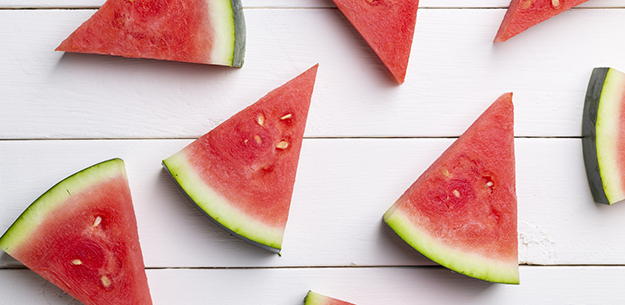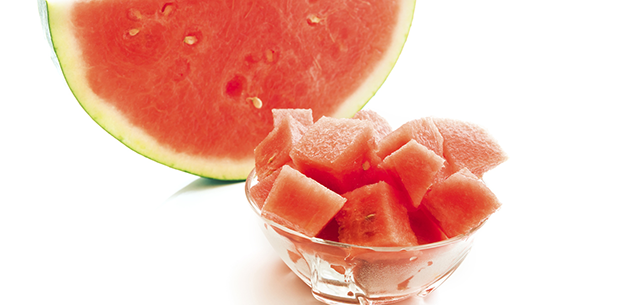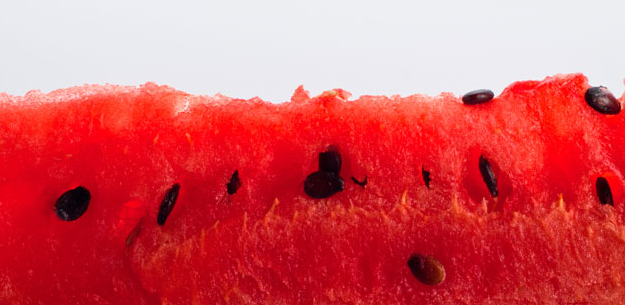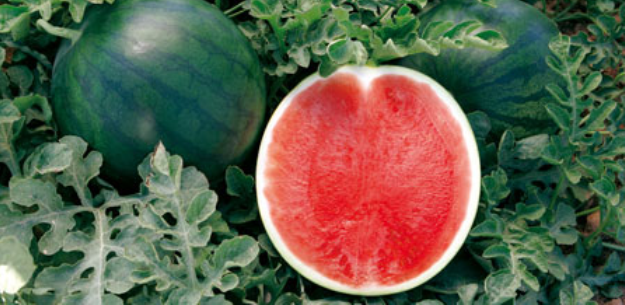.png.transform/rendition-xs/image_image%20(1).png)
Spain’s Summer Sweetheart
There are few fruits that announce the arrival of summer quite as sweetly and cheerfully as the watermelon. While it is typically available from late Spring to mid-Fall, this juicy fruit makes its grandest appearance in early Summer, cropping up in markets, on menus and at every hot-weather event imaginable. It turns out that Spain is not only enjoying this bountiful crop at home, but is also exporting it all over Europe, thus proving to what extent watermelon is, in fact, Spain’s summer sweetheart

Some say that the best way to choose a good watermelon is to tap on its rind with a couple of fingers and listen for a hollow sound. Others insist that you only have to pick one up and confirm that it is relatively heavy to know that it will be ripe and juicy within. Although watermelons are easily cultivated in greenhouses and are therefore available year-round in Spain, they are mostly grown on large outdoor farms. During the summer season, be assured that almost any Spanish watermelon you pick at the market will be sweet and refreshing, juicy and crisp.
Thought to have originated in Africa, watermelon, or sandía, as the fruit is called in Spanish, have been traced to both the Kalahari Desert (Namibia and Botswana) and the Nile River Valley (Egypt), where its seeds have been discovered in Pharaonic tombs. The fruit was most likely brought to Spain by the Moors around the 13th century. Whatever its origins, there is no doubt that the plant was well adapted to the hot, dry climate of the Mediterranean coastal area.
With an annual production of approximately 969,327 metric tons in 2016, Spain is one of the world’s largest producers of this cosmopolitan fruit. In fact, 2016 statistics from the United Nations Food and Agriculture Organization, ranked Spain as 13th in the world and 1st in Europe in terms of watermelon production. The country’s most important cultivation areas include Murcia, Almería and Valencia, with each region accounting for approximately 30% of total production. Watermelons are also grown in the autonomous regions of Castile-La Mancha and Andalusia.
Color range

The watermelon, one of the world’s largest fruits, is actually a berry with a thick, smooth rind and a fleshy interior that grows on a flowering vine. While most people think of watermelons as having green rinds and rosy centers, they can actually range from white, yellow, light green, spotted and streaked in color on the outside, to shades of pinks, reds and shocking orange-yellows on the inside. They also vary drastically in size and weight, and can be oblong, oval or spherical in shape. Some are even grown inside glass containers to achieve a cubical form.
Another important distinction is whether or not watermelons have seeds. In Spain, the most common seeded varieties include Crimson Sweet, Sugar Baby, Resistant, Early Star and Dulce Maravilla. In general, these are large, round watermelons that have an almost black-green rind and red interior. Traditionally, this is what Spaniards think of when they think of watermelons. As far as seedless varieties go, the most significant include Reina de Corazones, Apirena, Pepsin and Jack, all of which tend to have a lighter green, streaked exterior and either a brilliant red or yellow flesh.
Although both seeded and seedless varieties are cultivated and consumed in Spain, the market for seedless watermelons really seems to be taking off. Cooperative associations such as Anecoop and Asociación Grupo Fashion (AGF), which promote and represent Spanish watermelon producers, are betting on the continuing strength of this growing industry by investing in new lines of research, innovation and marketing, albeit through different approaches.
Ceding to seedless

On the one hand, Anecoop, which represents 29 Spanish watermelon cooperatives, has been the most significant purveyor of watermelons in Europe for the past twenty years. Of the approximately 108,000 tons of watermelon production projected by the company in 2016, 78,000 belong to seedless varieties. The most popular is the Seedless Red Watermelon (64,000 tons), followed by the Mini Seedless (10,000 tons) and the Yellow and Black Seedless varieties (with 2,000 tons apiece). Additionally, the largest sales increase has occurred with the Mini Seedless variety, which has almost doubled its production since last year. These small watermelons are the result of over 1,300 varietal tests conducted over 25 years, and therefore reflect how research and development play a direct role in the development of product lines. Like the company’s other seedless varieties, the Mini Seedless are sold under the Bouquet brand and are exported to 23 countries, with particular emphasis on France and Germany.
In an effort to extend their national market, Anecoop has opted to focus on spreading the word on its products through a campaign that centers on social networks such as Facebook and Twitter, and that highlights presentations aimed at increasing fruit and vegetable consumption among children. Internationally, the company has organized an extensive advertising campaign that includes train and metro ads in heavily transited European stations, tasting opportunities and other related events aimed primarily at consumers in France, the Czech Republic, Austria and Germany. AGF is another key player that contributes to the approximately 490,000 tons of Spanish watermelons exported annually. This cooperative was founded in 2002 and now brings together 24 Spanish companies, 15 of which are located in Almería. However, unlike Anecoop, AGF promotes a single variety of watermelon that was developed in conjunction with the prestigious Nunhems seed company. The idea was to produce a fruit of consistent quality with regard to appearance, taste and other characteristics, such as texture and sugar levels. Known as Sandía marca Fashion (Fashion brand watermelon), this seedless watermelon is large and round with a dark green, uniform exterior and a bright pink, juicy flesh that is both sweet and crunchy.
With this initiative, the association hopes to give consumers a product quality guarantee, and also provide assurances with regard to their use of good practices, such as sustainable agriculture, semi-organic farming, biological pest control and strict safety measures. In addition to being available in Spain through a number of different outlets from supermarkets to farmer’s markets, 40% of the company’s production is exported to countries throughout Europe.
Healthful melons

As part of their marketing effort, Sandía Fashion has been trying to get the word out about watermelon’s nutritional values and health benefits, as well as the huge range of gastronomic possibilities that the fruit presents. Watermelons are composed of about 92% water, which not only helps to explain their name, but also suggests their refreshing and diuretic qualities. In addition to their high water content, watermelons are rich in vitamins A, B and C, while varieties with pink or red flesh contain a high level of the powerful antioxidant, lycopene, which is thought to help prevent prostate and other cancers. Another benefit of watermelon is its citrulline content. This amino acid is used by our bodies to make arginine, another amino acid that helps eliminate ammonia from cells, improve circulation and reinforce the immune system.
As far as gastronomic applications are concerned, the possibilities for eating watermelon go far beyond picnics and fruit salads. With the help of Chef Josué Rodríguez of Garum Restaurant in Adra, Almería, the Asociación Grupo Fashion creates an annual “cookbook” of recipes using watermelon. It is distributed, along with the nutritional data, in a colorful booklet that is available for free in markets and supermarkets where the fruit is sold, or online at www.sandiafashion.com.
This year’s recipes include adaptations of well-known dishes such as watermelon gazpacho and watermelon Macedonia with citrus fruits and lemon-thyme (Macedonia de sandia con cítricos al tomillo limón), as well as more innovative creations that include: watermelon skewer in tempura (Brocheta de sandía en tempura), watermelon cubes filled with mango vinaigrette and clams (Cubiletes de sandía fashion rellenos de vinagreta de mango y berberechos), deep fried watermelon “sandwich” with Ibérico ham and brie (San Jacobo de sandía, jamón ibérico y queso brie), and duck foie gras with watermelon slivers (Hígado graso de pato con lamas de sandía fashion).
Whether you eat it prepared in a recipe, or recently carved and dripping juicily down your chin, there are more than enough reasons why Spanish watermelon consistently appears on menus and tables as soon as the weather turns hot. As a sweet and refreshing treat, gastronomic ingredient, healthy snack or successful commodity, Spanish watermelon has proved it has what it takes to “beat the heat”, both here and abroad.
Some say that the best way to choose a good watermelon is to tap on its rind with a couple of fingers and listen for a hollow sound. Others insist that you only have to pick one up and confirm that it is relatively heavy to know that it will be ripe and juicy within
Adrienne Smith/©ICEX

